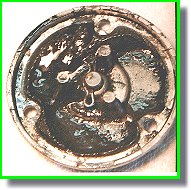Tech Tip 6 Why do I need to change my oil

Tech Tip #6
Why do I need to Change My Oil?
Speaking of heat, another job of oil is to carry heat away from the hot spots to be transfered to a cooler area of the motor, usually the crankcases or an oil cooler if available, by convection. Convection is the passage of heat from a hot object to a cooler one. Heat tries to equalize within a motor and oil is one of the conduits for it.
conduits for it.
Finally, oil carries away combustion by-products, coats them and holds them in suspension to prevent these substances from attacking the internal motor parts. Combustion by-products? Like water or acids consisting of partially burnt gasoline that manage to get passed the rings and would damage any exposed metal if the engine’s oil didn’t disburse them. However there is a limit to the amount of contaminants that the oil can safely handle. When the limit is reached, they fall out of suspension and collect in the bottom of the engines crankcases as sludge. (Photo 1) This sludge has no lubrication value, no heat transfer ability and since it is almost pure contaminants , can’t pick up any more. It’s only function once it has collected on the bottom of the crankcases is to start contaminating any fresh oil that is introduced during an oil change. (Photo 2)
contaminants that the oil can safely handle. When the limit is reached, they fall out of suspension and collect in the bottom of the engines crankcases as sludge. (Photo 1) This sludge has no lubrication value, no heat transfer ability and since it is almost pure contaminants , can’t pick up any more. It’s only function once it has collected on the bottom of the crankcases is to start contaminating any fresh oil that is introduced during an oil change. (Photo 2)
How to get rid of sludge once formed? Disassemble your motor and flush it out! So don’t let sludge form in the first place! CHANGE YOUR OIL EVERY 5 TANKS OF FUEL FOR AIR-COOLED 4-STROKES, 7 IF WATER-COOLED. Why a longer interval for water-cooled engines? Water-cooled motors run cooler so the oil isn’t subjected to the higher temperatures that occur in an air-cooled motor. Oil lasts much longer if kept under 200°F. So measure your oil temperature with a digital cooking thermometer inserted into the dipstick hole. If you regularly are on the high side of 200°F then consider the addition of an oil cooler. Your motor will thank you with a longer service life.
